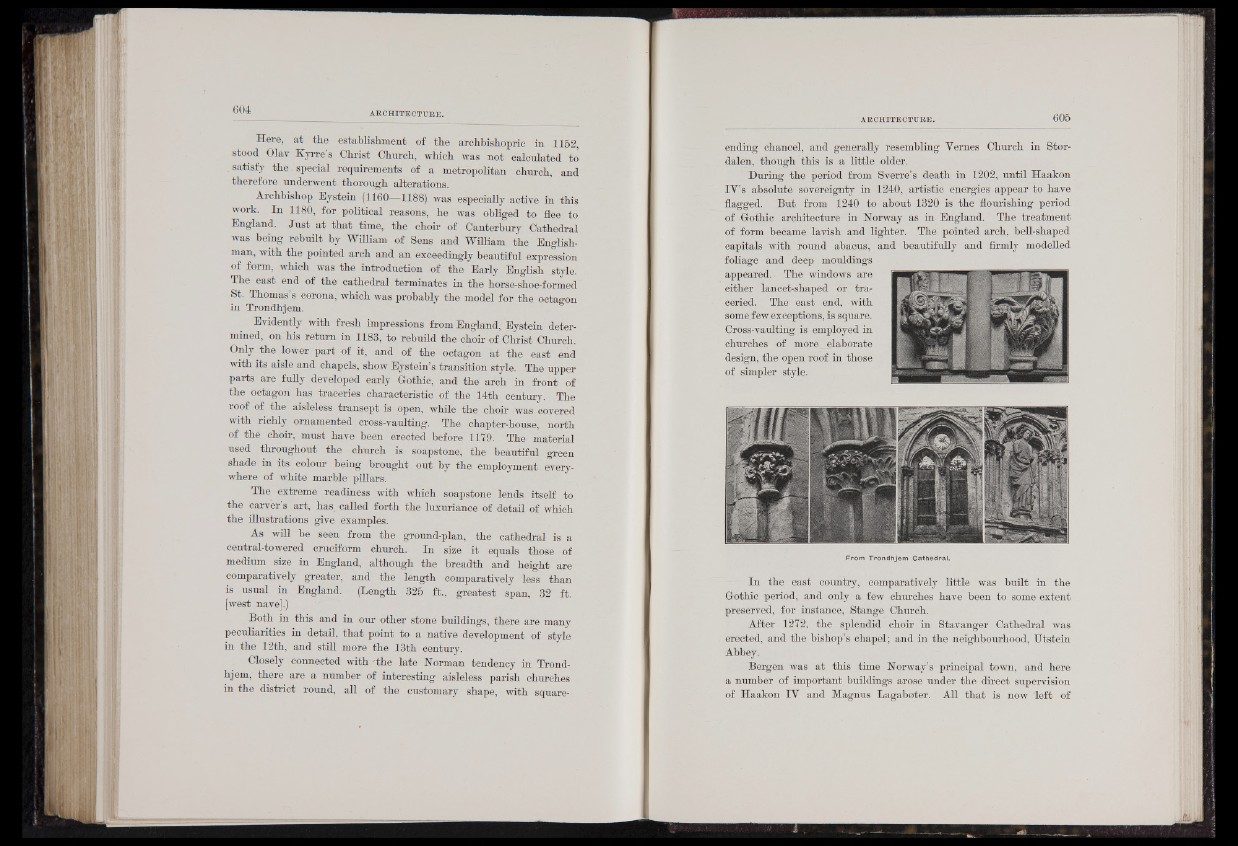
Here, at the establishment of the archbishopric in 1152,
stood Olav Kyrre’s Christ Church, which was not calculated to
satisfy the special requirements of a metropolitan church, and
therefore underwent thorough alterations.
Archbishop Eystein (1160—1188) was especially active in this
work. In 1180, for political reasons, he was obliged to flee to
England. Just at that time, the choir of Canterbury Cathedral
was being rebuilt by William of Sens and William the Englishman,
with the pointed arch and an exceedingly beautiful expression
of form, which was the introduction of the Early English style.
The east end of the cathedral terminates in the horse-shoe-formed
St. Thomas s corona, which was probably the model for the octagon
in Trondhjem.
Evidently with fresh impressions from England, Eystein determined,
on his return in 1183, to rebuild the choir of Christ Church.
Only the lower part of it, and of the octagon at the east end
with its aisle and chapels, show Eystein’s transition style. The upper
parts are fully developed early Gothic, and the arch in front of
the octagon has traceries characteristic of the 14th century. The
roof of the aisleless transept is open, while the choir was covered
with richly ornamented cross-vaulting. The chapter-house, north
of the choir, must have been erected before 1179. The material
used throughout the church is soapstone, the beautiful green
shade in its colour being brought out by the employment everywhere
of white marble pillars.
The extreme readiness with which soapstone lends itself to
the carver s art, has called forth the luxuriance of detail of which
the illustrations give examples.
As will be seen from the ground-plan, the cathedral is a
central-towered cruciform church. In size it equals those of
medium size in England, although the breadth and height are
comparatively greater, and the length comparatively less than
is usual in England. (Length 325 ft., greatest span, 32 ft.
[west nave].)
Both in this and in our other stone buildings, there are many
peculiarities in detail, that point to a native development of style
in the 12th, and still more the 13th century.
Closely connected with the late Norman tendency in Trond-
hjeni. there are a number of interesting aisleless parish churches
in the district round, all of the customary shape, with squareending
chancel, and generally resembling Yemes Church in Ster-
dalen, though this is a little older.
During the period from Sverre’s death in 1202, until Haakon
IY’s absolute sovereignty in 1240, artistic energies appear to have
flagged. But from 1240 to about 1320 is the flourishing period
of Gothic architecture in Norway as in England. The treatment
of form became lavish and lighter. The pointed arch, bell-shaped
capitals with round abacus, and beautifully and firmly modelled
foliage and deep mouldings
appeared. The windows are
either lancet-shaped or tra-
eeried. The east end, with
some few exceptions, is square.
Cross-vaulting is employed in
churches of more elaborate
design, the open roof in those
of simpler style.
From Trondhjem Cathedra).
In the east country, comparatively little was built in the
Gothic period, and only a few churches have been to some extent
preserved, for instance, Stange Church.
After 1272, the splendid choir in Stavanger Cathedral was
erected, and the bishop’s chapel; and in the neighbourhood, Utstein
Abbey.
Bergen was at this time Norway’s principal town, and here
a number of important buildings arose under the direct supervision
of Haakon IV and Magnus Lagaboter. All that is now le ft of